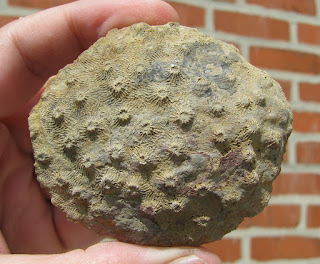The largest is this 8" (22cm) plate which is a complete, intact colony. This is the ventral surface
A closer view of the individual calices
The colony is somewhat squat and spread out which indicates that there was little influx of sediment that would otherwise cause it to grow upwards more that outwards.
A view of the dorsal surface which was in contact with the substrate. The lack of an obvious hard attachment point indicates the colony grew on a semi-solid substrate rather than on top of other debris.
A closer view of the dorsal surface. The epitheca appears to have taken the brunt of the weathering as you can see some of the coral structure rather than a plain surface.
I also got a few smaller, hand sized samples like this specimen.
And this one which also features a horn coral cousin on the side.
Note that this specimen exhibits some rejuvinational growth, perhaps initiated after a storm partially covered the colony.
Here is the horn coral that decided to use the Phillipsastrea as it's hard ground. Note that the horn coral does not appear to be affecting the growth of the coral it colonized (as no evidence of subsequent growth by the Phillpsastrea can be see). The horn coral, in fact, made more stabilizing attachments to the Phillipsastrea as it grew. I interpret this as evidence that the Phillipsastrea colony had been smothered or otherwise died, and the horn coral took advantage of a hard substrate to establish itself, only later to succumb to another storm and be smothered itself.
All three specimens came from Morocco and are from the Devonian period. It comes from the Taouz region but I do not have any other locality information for it.
















No comments:
Post a Comment